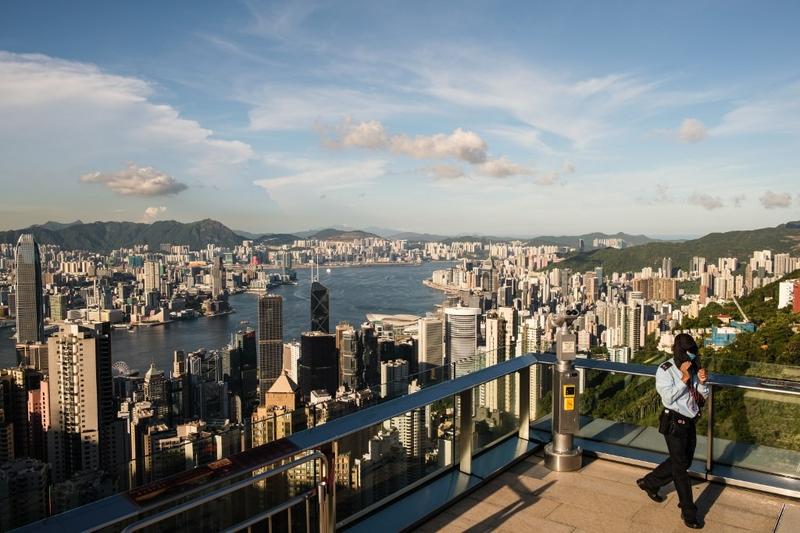 A member of security walks along a viewing platform on Victoria Peak, Hong Kong on July 28, 2020.
(ANTHONY WALLACE / AFP)
A member of security walks along a viewing platform on Victoria Peak, Hong Kong on July 28, 2020.
(ANTHONY WALLACE / AFP)
HONG KONG - The overall air quality in Hong Kong has improved due to the continuous implementation of emission reduction measures and collaboration with Guangdong province, the city’s Environmental Protection Department said Friday.
Announcing an overview of the city’s air quality in 2020, the department said that from 1999 to 2020, the ambient concentrations of major air pollutants, including respirable suspended particulates, fine suspended particulates, nitrogen dioxide (NO2) and sulphur dioxide have been reduced by 43 percent to 80 percent from their highest levels.
The Environmental Protection Department said that commercial vehicles only account for about 20% of the total number of cars, but they are the main source of nitrogen oxide emissions at the roadside
In 2020, the overall ambient annual average concentrations of these pollutants in the city met the Air Quality Objectives (AQO) limits.
Regarding smog, the department said the number of hours of reduced visibility in Hong Kong has been greatly reduced by 78% from its peak.
Although roadside NO2 shows a significant declining trend, it is still at a high level with the annual average concentration in 2020 exceeding the AQO’s limit.
It noted that commercial vehicles only account for about 20 percent of the total number of cars, but they are the main source of nitrogen oxide (NOx) emissions at the roadside. Therefore, commercial vehicles will remain the focus of the government’s efforts to improve roadside air quality, the department said.
Ambient ozone (O3) is still on a long-term upward trend, the department said, adding that O3 is a complicated air pollution issue as well as a regional issue.
READ MORE: HK gets down to the business of advanced air quality control
It explained that O3 is not directly emitted from pollution sources but formed by photochemical reactions between NOx and volatile organic compounds (VOC) under sunlight.
The rise in the city’s O3 in recent years could be attributed to high regional background O3 and reduced NOx emissions from local vehicles.
The department said it will step up control on VOCs, enhance regional collaboration and conduct scientific studies to deal with the O3 problem.
The Hong Kong and Guangdong governments have commenced a study on post-2020 regional air pollutant emission reduction targets and concentration levels to formulate emission reduction targets to 2030.
The Hong Kong and Guangdong governments have commenced a study on post-2020 regional air pollutant emission reduction targets and concentration levels to formulate emission reduction targets to 2030
To combat the regional O3 problem, the governments of Hong Kong, Guangdong and Macao will launch a three-year joint study on ozone formation as well as regional and super-regional transportation characteristics in the Guangdong-Hong Kong-Macao Greater Bay Area.
The Hong Kong Special Administrative Region government is also installing a light detection and ranging system to measure real-time vertical and three-dimensional distribution of the concentrations of O3 and particulates as well as meteorological data at higher altitudes to track the transportation of pollutants over Hong Kong, with a view to formulating policies to reduce O3 pollution.
ALSO READ: Cleaner skies
Additionally, the Hong Kong SAR government will launch Hong Kong’s first roadmap on the popularization of electric vehicles in the first quarter of the year.
It will also later update the Clean Air Plan for Hong Kong to formulate long-term plans to further improve the city’s air quality.


